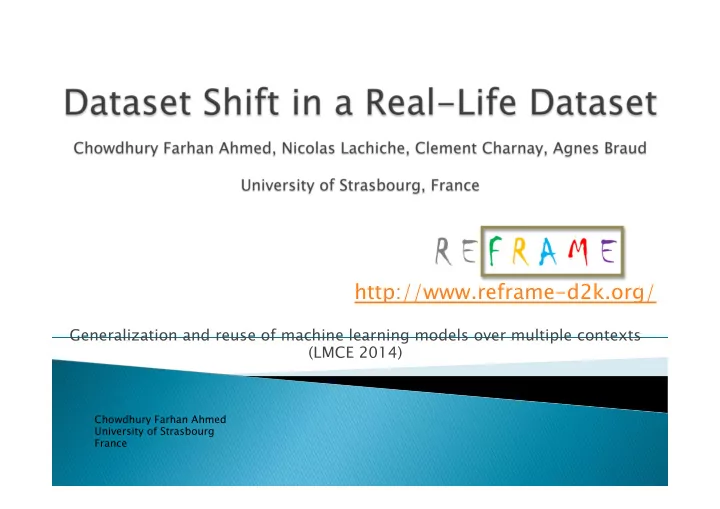

http://www.reframe-d2k.org/ Generalization and reuse of machine learning models over multiple contexts (LMCE 2014) Chowdhury Farhan Ahmed University of Strasbourg France
! Introduction and Motivation ! Related Work ! Description of the Bike Sharing Dataset ! Occurrences of Dataset Shift ! The Split of Kaggle ! Bike Sharing for Dataset Shift and More… 2
! Dataset shift (Moreno-Torres et al. 2012) refers to the problem where training and testing datasets follow different distributions. ! Although it is natural to observe dataset shift in real-life datasets, unfortunately, existence of clear dataset shift is rarely found in the publicly available real-life datasets. The existing methods used either synthetic or non-publicly available real-life datasets. ! Here we present the existence of remarkable dataset shift in a publicly available dataset called Bike Sharing (Fanaee-T et al. 2014). ! We experimentally analyze how to split the dataset to achieve dataset shift in both input and output variables. ! Future research directions are discussed where this dataset can effectively be used as a real-life benchmark. Temp > 18 Temp > 25 Yes No Yes No Don’t buy Buy Ice-cream Don’t buy Buy Ice-cream City 1 City 2 Fig 1: An example of dataset shift. 3
! Some methods have been proposed to perform adjustment on the model output when to be applied over different contexts, such as ◦ Tuning multi-class classification problem (Charnay et al. 2013). ◦ Cost-sensitive regression model (Zhao et al. 2011). ◦ ROC curve for regression (Hernandez-Orallo et al. 2013). ! Input variable shift is most often known as covariate shift in machine learning. Research has been done to tackle covariate shift such as ◦ Importance Weighted Cross Validation (IWCV) (Sugiyama et al. 2007). ◦ Integrated Optimization Problem (Bickel et al. 2009). ◦ Kernel Mean Matching (Gretton et al. 2009). ! An input transformation based method, called GP-RFD (Moreno- Torres et al. 2013) (Genetic Programming-based feature extraction method for the Repairing of Fractures between Data) has been proposed for handling dataset shift. 4
! The Bike Sharing Dataset (Fanaee-T et al. 2014) contains usage logs of a bike sharing system called Capital Bike Sharing (CBS) at Washington, D.C., USA for two years (2011and 2012). ! It is publicly available in UCI Machine Learning Repository. ! It contains bike rental counts in both hourly (17,379 records) and dialy (731records) formats based on environmental and seasonal settings. ! The input variables contain day, hour, season, workday/ holiday and some weather information such as temperature, feels like temperature, humidity and wind speed. ! The original objective of the creators of this dataset was event and anomaly detection. 5
! In real-life weather changes according to the change of seasons. Moreover, the renting behaviour of people may also change according to time. ! We have splitted this dataset into four parts according to four months of sequential time and labelled as Spring-11, Fall-11, Spring-12 and Fall-12 (Spring: January to June, Fall:July- December) ! We have taken four most influential input attributes of this dataset representing weather information. The values of this attributes have been normalized as follows ◦ Temperature: The values (Celsius) are normalized by dividing by 41 (max). ◦ Feels Like Temperature: The values (Celsius) are normalized by dividing by 50 (max). ◦ Humidity: The values are normalized by dividing by 100 (max). ◦ Windspeed: The values are normalized by dividing by 67 (max). ! These splits contain remarkable dataset shift. Other possible splits for observing dataset shifts are with respect to months, seasons and years. 6
0.7 300 0.6 250 0.5 200 Spring-11 11 0.4 150 Fall-11 Bike Rental Count 0.3 (a) (b) Spring-12 12 100 0.2 Fall-12 50 0.1 0 0 Temperature Feels Like Like Humidity Windspeed Spring-11 Fall-11 Spring-12 Fall-12 Fig 2: Distribution of the average values of (a) input and (b) output attributes in the semester splits. Table 1: Performance of the base model Spring-11 in other semesters Deployment Source Measure Spring-11 Fall-11 Spring-12 Fall-12 MAE 71.789 102.293 132.226 158.884 Spring-11 RMSE 99.058 135.427 186.459 224.307 7
! Recently, Kaggle has provided a problem on Bike Sharing Dataset. ! The original dataset has been divided into two parts called Train and Test. ! The Train part contains data of each month from day 1 to 19, and the Test part contains data from day 20 to the end of a month. ! The problem is to build a regression model with the Train dataset and predict the bike rental counts in the Test dataset. ! Here, dataset shift is absent because of mixing data of every month in the Train and Test datasets. 8
0.7 300 0.6 250 0.5 200 0.4 150 Train Bike Rental Coun ount 0.3 Test (a) (b) 100 0.2 50 0.1 0 0 Temperature Feels Like Humidity Windspeed Train Test Fig 3: Distribution of the average values of (a) input and (b) output attributes in the Kaggle split. Table 2: Performance of the base model Train in Test for the Kaggle split Deployment Source Measure Train Test MAE 117.595 117.17 Train RMSE 158.607 157.517 9
Time/Weather/Bike Rental Classification/Regression/ Time Series Data Mining Shifts available in Incremental/ Seasons/ Online/Data Stream Semesters/Years Bike Sharing as a Benchmark Transfer Learning/ Dataset Shift/ Multi-Level Learning Domain Adaptation Day/Hour Format 10
11
Recommend
More recommend